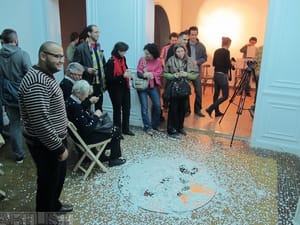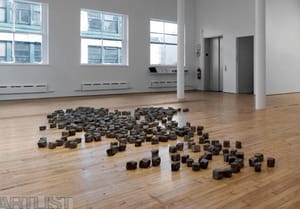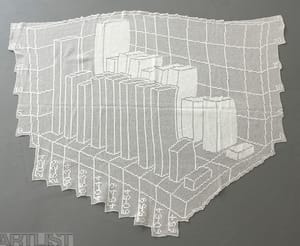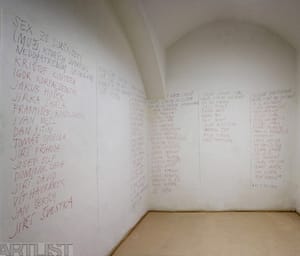- First Name
- Lucia
- Surname
- Tkáčová
- Born
- 1977
- Birth place
- Banská Štiavnica, Slovensko
- Place of work
- Bratislava, Prague
- Website
- www.chitka.info
- CSU Library
- ↳ Find in the catalogue
About artist
There are many words we could use to describe the work of the creative duo comprising Anetta Mona Chisa, a Romanian artist who also works in Slovakia and the Czech Republic, and the Slovak artist Lucia Tkáčová, but boring is not one of them. Since 2000 they have been collaborating on works that are simply articulated yet highly expressive. However, by no means does this imply shallowness. The focus of the artists on the gender and political aspects of the institutional level of the art scene and on the general societal context is accompanied by a sensitive, restrained distance, in which the humour and complexity of the issues together exceed the boundaries of purely ideological considerations.
In their older works, such as The Red Library (2005), in which they evaluate the male component of the Czech art scene from a purely sexist viewpoint, or the series of videos Dialectics of Subjection (2004-2006), which takes the form of a series of light-hearted dialogues between the artists on the topic of the masculine hierarchy of the art world and the sexual aspects of its actors, a significant feature of their work is the inversion of the active male subject and passive female erotic object. However, here this ironic game is also part of the artists’ striving for success and fame within the very system they criticise. Chisa and Tkáčová also deploy humour in another of their projects, which relates to institutional criticism. Since 2005, as part of the project Private collection, the collection in question contains many commonplace articles stolen by the artists from leading international galleries. What was originally an object with a certain use value becomes a “consecrated” exhibit in an exhibition by virtue of its provenance. Chisa and Tkáčová also reflect on political and economic themes, also sometimes relating to gender questions, as in When Labour Becomes Form (2007). Elsewhere, for instance in 80:20 (2011), their contribution to the Romanian pavilion at the Venice Biennale, they applied the Pareto Principle, which examines the unequal way that wealth is distributed in society, to the institutional aspects of their own participation in this event.
Over recent years the work of Chisa and Tkáčová has become more expressive and even monumental, while remaining based on a similar thematic, conceptual starting point as in the works above. Both the video Try again, Fail again, Fail better (2011), and the installation Either Way, We lose (2012) work with a monumental inflatable fist, the kind that is raised as a symbol of protest and rebellion. In the video it becomes a controlled and controlling puppet that drags its “puppeteers” around at least to the same extent as they drag it. This parable about the ambiguity between an image representing protest and its meaning tells us a lot about the long-term creative considerations of the artists linked with a dialectical understanding of the ideas and topics they present. Clearly this is also related to the “binary-uniqueness” they enjoy as a creative duo. This aspect of their work is exemplified in Vessel (i aM a venus, A conch, a kiT, a Cat, a Lot) (2012), at first sight a vase on which both artists worked, but in fact a bust with two faces.
- Author of the annotation
- Viktor Čech
- Published
- 2015
CV
2006, Together with Lucie Tkáčová laureate Oskár Čepan Award
1994 - 2000 Academy of Fine Arts in Bratislava
Exhibitions
- Solo exhibitions
-
(s Annetou Monou Chisou)
2014
a ManuaL to hAck atavisTic oCean, P/art, Reeperbahn 110, Hamburg
2013
a Lack, A touch, an aTavisM, a notiCe, Hit gallery, Bratislava aCtivaTe aMok, not a causaL chAin, waterside contemporary, London
2012
i aM a venus, A conch, a kiT, a Cat, a Lot, Rotwand gallery, Zurich Either Way, We Lose, Sorry we're closed, Brussels A B C D E F G H I J K L M N O P Q R S T U V W X Y Z (s Janou Želibskou), Make Up Gallery, Košice
2011
The Diplomatic Tent (s Ionem Grigorescu), Salonul de proiecte, Bucharest Performing History, Romanian Pavilion (s Ionem Grigorescu), 54 Biennale di Venezia Material Culture / Things in our Hands, Christine Koenig gallery, Vienna The More You Tell Me, the Stronger I Can Hit, Tarsaskor gallery, Budapest
2010
How to Make a Revolution, MLAC, Rome Far from You, Karlin Studios, Prague
2009
Wager, Collectiva gallery, Berlin Fair Sex, Hermitage gallery, Chicago Footnotes to Business, Footnotes to Pleasure, Christine Koenig gallery, Vienna
2008
Anetta Mona Chisa & Lucia Tkacova, Neuer Berliner Kunstverein, Berlin Blondes Must Be Stopped, Purple Room, Rome Romantic Economies, Medium gallery, Bratislava
2006
Everything is Work, Tranzit, Bratislava Magical Recipes for Love, Happiness and Health, f.a.i.t. gallery, Cracow Ortografio de Potenco, Futura gallery, Prague Man, Hero, Spirit, Machine, Medium gallery, Bratislava
2005
The Red Library, Jeleni gallery, Prague Videosomic, Space gallery, Bratislava
2003 A Room of Their Own, Medium gallery, Bratislava
- Group exhibitions not included in ARTLIST.
- 2014 Mobile biennale 1, National Museum of Contemporary Art Bucharest The iron curtain, Kunstsammlung, Linz Who is the director?, 4+4 days in motion, Styblo palace, Prague Afterimage. Rappresentazioni del conflitto, Galleria Civica, Trento Parkfair - terminartor, Ehrenhalle, Vienna Menagerie, or Artwork Not About Love, Elaine L. Jacob gallery, Detroit RE002_We Were All Rocks Once, Sorbus-galleria, Helsinki Audio Trouble, Centre d'art contemporain La Halle des bouchers, Vienne Slovenske Narodne Povstanie, Kunsthalle Kosice Intimity, Galerie Kai Erdmann, Hamburg Work, Cyprian Majernik gallery, Bratislava Bash II, Byrdcliffe's Kleinert/James Gallery, Woodstock, New York Power & Play, De Markten, Brussels Unlooped-KINO, Manifesta 10, St Petersburg La fureur de vivre, La Brasserie / Centre d'Art Contemporain, Foncquevillers Kongress der Artikulation, Kunstraum Kreuzberg Bethanien, Berlin WoWmen!, Kaaitheater, Brussel Private Nationalism, Kunsthalle Kosice FEMINismTC, urban space of Vienna Time Pieces., Nordstern Videokunstzentrum, Gelsenkirchen 7.000.000.000, Espai d'art contemporani de Castello, Castello 2013 1848, Central Slovakian Gallery, Banska Bystrica Art Video Lounge, Works from the Collection of the Video-Forum n.b.k., CONTEXT Art Miami 2013, Miami Upside Down - let's dance, Cultuurcentrum Strombeek, Strombeek-Bever RE_001: First Communion of Anemic Young Girls in the Snow and other works, Interstate Projects, Brooklyn, New York You always return to the water, Rotwand gallery, Zurich Contextual art, Cyprian Majernik gallery, Bratislava Bueroarbeit, Years, Copenhagen Liquid Assets: In the Aftermath of the Transformation of Capital, Steirischer herbst, Graz The Oracle: what is your prophecy for the future?, the Wand, Berlin An I for an Eye, Austrian Cultural Forum New York The Second Lore, CUAC - contemporary art, Salt Lake City Good Girls_Memory, Desire, Power, National Museum of Contemporary Art (MNAC), Bucharest Negative Capability, Galleria Enrico Astuni, Bologna In This Pavilion One Can See Art, tranzit.ro, Bucharest 10 Jahre Lentos, Lentos Art Museum, Linz Minimal Compact, Christine Koenig gallery, Vienna Qual & Wahl, Kunstverein Wolfsburg, Wolfsburg There must be order - Nine artists from Central Europe, Viafarini DOCVA, Milan S'Long As It's Yours, Gallery Aferro, Newark Clash!, Art in General, New York 2012 What Does a Drawing Want?, Beirut, Cairo Down on Mainstream, Cultuurcentrum Strombeek, Strombeek-Bever P L A Y_N A T U R E_W O R K_F U T U R E, Tschechisches Zentrum Berlin Drifting Identities, Museum of Zemstvo, Chisinau The Real Emotions, National Art Museum Cluj, Cluj-Napoca Present Unlimited, Fabrika 126, Sofia Vermessung des Donauraumes. Positionen aktueller Kunst., Kunstforum Ostdeutsche Galerie, Regensburg In 15 min everyone will be in the future, Turkish bath, Plovdiv Body Language - works from the Fotomuseum Winterthur Collection, Centre culturel suisse, Paris Ready, Set, Go!, Nitra gallery, Nitra Artists Film International, Whitechapel Gallery, London 3rd Moscow International Biennale for Young Art, Moscow Beautiful Game, City Art gallery of Ljubljana The Circus Crew, LARMgalleri, Copenhagen DOMESTICating, erg's gallery, Brussels Doppio gioco - Double Game. The Ambiguity of the Photographic Image, Fondazione Bevilacqua La Masa, Venice Care Crisis, Futura gallery, Prague Exit Order - New Situation, Glockengasse No9, Vienna Demonstrations. Making Normative Orders, Frankfurter Kunstverein, Frankfurt Rearview Mirror, Art Gallery of Alberta, Alberta 2011 ironapplaus.net, Slovak National gallery, Bratislava Eyes Looking for a Head to Inhabit, Muzeum Sztuki Lodz The Global Contemporary, ZKM | Museum fue Neue Kunst, Karlsruhe The 29th Biennial of Graphic Arts in Ljubljana, The International Centre of Graphic Arts, Ljubljana Zeroth Years, Povazska gallery - Museum of Art Zilina In Between Frames, MNAC, Bucuresti Rearview Mirror, The Power Plant - Contemporary Art gallery, Toronto The Bergen Accords, Hordaland Art Centre, Bergen Uber Dinge, Kunsthaus Muerz, Mürzzuschlag Models For Taking Part, Presentation House gallery, Vancouver 2010 Hard to Sell, Good to Have, Palais Sturany, Vienna Figura cuncta videntis (the all-seeing eye) / Homage to Christoph Schlingensief, Thyssen-Bornemisza Art Contemporary, Vienna Transition Times - Art video d'Europe centrale, Paris Photo 2010 There Has Been No Future, There Will Be No Past, ISCP, New York Erased Walls, Mediations Biennale Poznan First Ural Industrial Biennial, Shockworkers of the Mobile Image, Ekaterinburg As You Desire Me, Contemporary Art Gallery of Brukenthal Museum, Sibiu Beyond Credit, Sanat Limani, Istanbul Over the Counter - The Phenomena of Post-socialist Economy in Contemporary Art, Mucsarnok Kunsthalle, Budapest Videodrome, Autocenter, Berlin Curated by_Vienna 2010 / Art&Film, Christine Koenig gallery, Vienna Starter - Works from the Vehbi Koc Foundation Contemporary Art Collection, ARTER - space for art, Istanbul Gender Check, Zacheta National Gallery of Art, Warsaw The artist in the (art) society, Motorenhalle, Dresden The Atrocity Exhibition, Feinkost gallery, Berlin While Bodies Get Mirrored, Migros Museum fur Gegenwartskunst, Zurich Cinema X: I Like to Watch, Museum of Contemporary Canadian Art, Toronto The Romance of my Young Days, the Future of my Nostalgia, Central Slovakian gallery, Banska Bystrica History, Memory, Identity: contemporary photography from Eastern Europe, Fondazione Cassa di Risparmio di Modena 2009 Formats of Transformation 89 - 09, Brno House of Arts / Museum auf Abruf, Vienna Communism never Happend, Feinkost gallery, Berlin Until the End of the World, AMP Gallery, Athens The Reach of Realism, Museum of Contemporary Art, Miami Gender Check, MUMOK Vienna Totale Erinnerung, Fotofestival Mannheim Ludwigshafen Heidelberg Donumenta, Kunstforum Ostdeutsche Galerie, Regensburg Don't Worry It's Only Money, City Art Rooms, Auckland, New Zealand Der Schnitt durch die Oberflache legt neue Oberflachen frei, Temporary gallery Cologne One day I will be a Star, Maison du Livre, de l'Image et du Son, Francois Mitterrand, Villeurbanne The Making of Art, Schirn Kunsthalle Frankfurt Working Memory, Tranzit, Bratislava Art Unlimited, Basel Things and Thoughts, Collectiva gallery, Berlin 2008 Young Artists' Biennial, Bucharest 6th Taipei Biennial, Taipei Fine Arts Museum Manual CC - Instructions for Beginners and Advanced Players, uqbar, Berlin All about Museum, Slovak National gallery, Bratislava Petit Histoires, Espace Apollonia, Strasbourg EL Gabinete Checo, Czech Centre Madrid Do Something Different, Barbican Centre, London L'Art en Europe, Domaine Pommery, Reims The Way Things Are ... Works from the Thyssen-Bornemisza Art Contemporary Collection, Centre of Contemporary Art, Torun Flowers of Our Lives, Centre of Contemporary Art, Torun 2007 GDP, M'ars Gallery, Moscow L'Europe en devenir, Centre Culturel Suisse, Paris Equal Opportunities, C2C gallery, Prague Humor Works, Skuc gallery, Ljubljana Public art Bucharest Bad Beuys Entertainment, Boling, Bruno, Chisa & Tkacova, collectif fact, Matsoukis, Mirza, Prévieux, Rungjang, Zucconi, Galerie West, Hague Bio Power, Medium Gallery, Bratislava Shooting Back, Thyssen-Bornemisza Art Contemporary, Vienna GDP, Municipal gallery, Prague Prague Biennale 3, Karlin Hall, Prague The Space Between, The Daryl Roth Theatre, New York New Video Art from Central Europe: Art Power, RISD Museum, Providence Locus Solus (talks of inanimate reason at the country estate), Myto, Mexico City "art world etiquette", ThreeWalls, Chicago The Collection, Trafo gallery, Budapest Partners in Crime, gallery MC, New York Culture Clash, Bastard gallery, Oslo 2006 Transfer, Muzej savremene likovne umetnosti, Novi Sad YVAA, The Kosova Art Gallery, Prishtina Arrivals>Slovakia, Turner Contemporary, Margate Marketenderin. Giveaways und Performances, Hartware MedienKunstVerein, Dortmund Runaway, Space Gallery, Bratislava Kuba: Journey Against the Current, Thyssen-Bornemisza Art Contemporary, Vienna Shadows of Humor, BWA Awangarda, Wroclaw Keine Wunderkammer, Hit gallery, Bratislava My Love is Dead, gallery Oel-Fruh, Hamburg Innenansicht, Kunstraum NOE, Vienna Frisbee, Dum panu z Kunstatu, Brno 2005 The Artist With Two Brains, NAB - Jewellery Quarter, Birmingham It Happenned Elsewhere, Vision Center, Cork Prague Biennale 2, Karlin Hall, Prague Iconoclash, The Spitz Gallery, London RE-SHUFFLE: Notions of an Itinerant Museum, Art in General, New York










